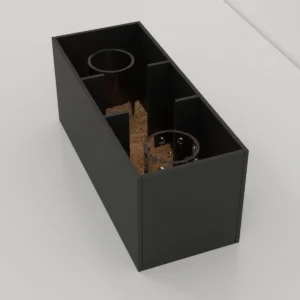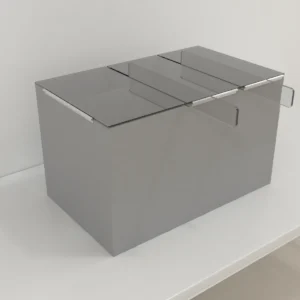$2,485.00 – $3,580.00Price range: $2,485.00 through $3,580.00
Developed by Kennedy and Shapiro, the Rodent Trident Maze was used to investigate how motivation and memory interact to guide adaptive behaviors. The researchers recorded neuronal activity from the hippocampus of rats performing two tasks while either food or water deprived. They found that motivational state had a stronger influence on hippocampal coding during contextual memory retrieval, where motivational cues were required to select among goal-directed actions.
The Rodent Trident Maze is composed of acrylic with three arms with three interchangeable goal boxes at 45° angle from a hexagonal central platform and start arm. The Rodent Trident Maze is a cross between a Y Maze and T Maze.

MazeEngineers empowers preclinical neuroscience research with meticulously designed, customizable behavioral apparatuses. From manual classic mazes to fully automated smart systems, we provide the tools scientists need to capture high-quality, reproducible data for studies on learning, memory, anxiety, and depression.

bool(false)


Mouse | Rat |
Start arm: 51 cm long; 3.8 cm wide; with edges 2.5 cm high | Start arm: 85 cm long; 6.4 cm wide; with edges 2.5 cm high |
Hexagonal central platform: 10.7 cm across | Hexagonal central platform: 17.8 cm across |
Three goal arms: 29 cm long; 3.8 cm wide; with edges 2.5 cm high; separated by 45° angle | Three goal arms: 49 cm long; 6.4 cm wide; with edges 2.5 cm high; separated by 45° angle |
Three interchangeable goal boxes: 18 cm high; 9 cm wide and 8.1 cm deep | Three interchangeable goal boxes: 30 cm high; 15 cm wide and 13.5 cm deep |
Acrylic | Acrylic |
Easy clean with 70% Ethanol | Easy clean with 70% Ethanol |
No Odors | No Odors |
Matte Finish to remove shine | Matte Finish to remove shine |
The Rodent Trident Maze was created to examine the interactions between motivational state and memory demand. Episodic memory is organized by spatial, temporal, and personal contexts, and can be modulated by motivational states arising from interoceptive cues. The hippocampus plays a key role in episodic memory by encoding organized associations among the multimodal elements that characterize an experience, and hippocampal neurons respond to organizing features of experience other than spatial context. Different motivational states can elicit distinct hippocampal codes in identical places, which can influence memory processes and help select among adaptive behaviors based on past experience. Using the Rodent Trident Maze, the motivational state examined was hunger and this on memory demand.
The Rodent Trident Maze is composed of acrylic which is available in the colours black, grey, blue, white, and clear. A start arm leads to hexagonal central platform. From the platform, three interchangeable arms radiate outwards at 45° angles. At the end of each is located a goal box.
Rodent location can be tracked using a video tracking software package such as Noldus EthoVision, ANY-Maze, or BehaviorCloud.
Pre-Training
Rats were food and water deprived on alternate days
Training:
Rats were trained to approach one goal box for food reward when hungry, a second goal box for water reward when thirsty, and to avoid a third goal box that was never rewarded. The goal boxes were moved randomly between the 3 possible goal locations after each trial. Rats were trained for 6 trials/day with 10-min inter-trial intervals until they reached and maintained an 80% correct choice criterion level of performance.
The following can be assessed using the Rodent Trident Maze
Motivational states activate distinct hippocampal representations to guide goal-directed behaviors
Kennedy and Shapiro (2009) explore the role of the hippocampus in guiding goal-directed behaviors during different motivational states. The authors use a rodent model and demonstrate that different motivational states, such as hunger or thirst, activate distinct hippocampal representations that help guide goal-directed behavior towards the appropriate outcome.
The experimental procedure involved six male Long Evans rats, maintained at 85% of their free-feeding body weight. The rats were trained in the Trident maze to approach one goal box for food reward, a second goal box for water reward, and to avoid a third goal box that was never rewarded. After the rats maintained the 80% correct choice performance for six consecutive days, they were implanted with recording electrodes, mounted on the skull over the left dorsal hippocampus. The recording sessions for the contextual memory retrieval task lasted approximately 50 min and included 25-35 trials.
As the rats performed the contextual memory retrieval task using the Trident maze, the results showed that hippocampal unit activity strongly distinguished the motivation-based memory retrieval conditions. The study also found that hippocampal neurons encoded multiple relationships among the salient features of the task, and that most task-sensitive fields clearly distinguished the conditions in each of the maze regions.
The findings suggest that the hippocampus plays a critical role in integrating motivational states with environmental cues to guide adaptive behavior. This research provides valuable insights into the neural mechanisms underlying motivated behavior and may have implications for understanding and treating psychiatric disorders.
Kennedy, P. J., & Shapiro, M. L. (2009). Motivational states activate distinct hippocampal representations to guide goal-directed behaviors. Proceedings of the National Academy of Sciences, 106(26), 10805–10810. doi:10.1073/pnas.0903259106
| Species | Mouse, Rat (500g) |
|---|
There are no questions yet. Be the first to ask a question about this product.